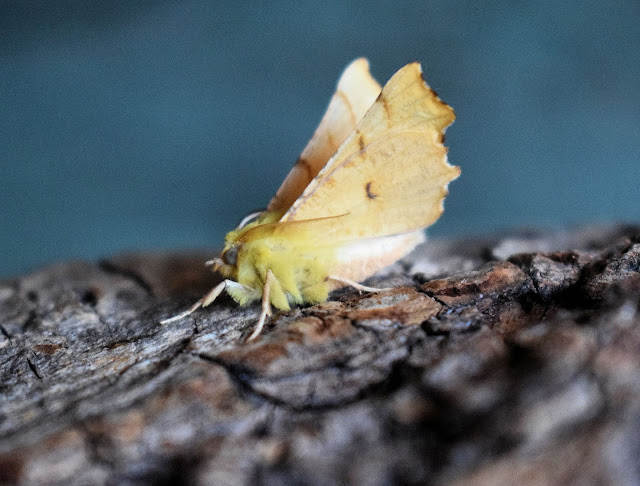Silver Y found resting on the curtains within the house. first one for the garden this year.
 |
| Silver Y |
22nd July
Good night in the trap with a few new species for the garden list.
Jersey Tiger, White Ermine ( F ), two Small Magpie Moths, Canary Shouldered Thorn *, Gypsy Moth *
Canary-shouldered Thorn Ennomos alniaria
Not hard to see why this moth was so named with its beautiful canary yellow thorax or shoulders.
just a single generation that flies between July to October, attracted to light and reported as quite common, frequents woodland, gardens, first one seen in my garden.
Gypsy Moth Lymantria dispar
 |
| Gypsy Moth Lymantria dispar |
Another first for the garden the Gypsy Moth, this one with its large bat ear antennae is the male, dark brown wings, the female is much lighter, almost white with black markings.
This moth considered in Europe as a common pest, bred in parts of London in the mid nineties where it was subjected to an eradication campaign by DEFRA. but is now resident in small colonies across the southeast. Its the larvae that causes the damage feeding on a range of deciduous trees.
Fortunately no females seen so hopefully no egg laying and subsequent foliage damage.
Others moths found in moth trap included the following
 |
| Small Magpie |
 |
| White Ermine (female) |
new additions for garden list :-
80.- Canary Shouldered Torn
81.- Gypsy Moth
18th July
Jersey Tigers being seen in the Garden and surrounding area in high numbers.
14th July
Six species in the trap from last night including one Nut tree Tussock probably second brood, Mother of Pearl seems very common around the night garden at the moment, one Scalloped Oak, two Ruby Tigers, one Bright-line, Brown-Eye. one Least Yellow Underwing
A Footman species new to the Moth Trap could be either Common Footman or the Scarce Footman
added to garden list :- 79. -Scarce Footman
 |
| Nut Tree Tussock |
 |
| Scalloped Oak |
 |
| Ruby Tiger |
 |
| Least yellow Underwing |
 |
| Bright-Line,Brown-Eye |
Scarce Footman Eilema complana
Looking at the collar on the two Footman found in the trap both had all yellow collars as described in the diagrams below, wings were held tight to the body as seen in the photographs, flies in July to August, said to inhabit Heathland and moorland habitats but found in the south and east of the country. not sure why it was in the garden habitat though ?
7th July
The Warm dry nights continue, another opportunity to put the moth trap out in the garden.
An excellent nights mothing for me with fourteen species found in the moth trap with just one new species for the garden in the form of a spectacular Elephant Hawk Moth, a moth I have been hoping to see in the garden.
the complete list is as follows
1. Dark Arches (2)
2.Elephant Hawk Moth * (1)
3. Ribband Wave (3)
4. Willow Beauty
5 Swallow Tail 92)
6. Heart & Dart
7. L-Album Wainscott
8. Clouded Silver
9. Lesser Yellow Underwing (5)
10. Mother of Pearl
11. Large Fruit tree Tortrix
12. Bright-Line, Brown-Eye (2)
13. White Ermine
Garden list as of 7/7/2018 - 78 - Elephant Hawk Moth
Elephant Hawk-moth - Deilephila elpenor
I have to admit my favorite moth caught to date, described as common, but this is the first I have seen in the garden for two seasons now. flying between May and July they are said to be attracted to light, they feed on the nectar of plants like Honeysuckle, fuscia.
The larvae which gives the moth its name because the head and neck resemble an elephants trunk feed on Rosebay willow herb.
distinguished from its smaller cousin the Small Elephant Hawk moth by the pink dotted line running down the centre of the thorax and the bars on the wings.
selection of moths caught on the Seventh of July
 |
| Dark Arches |
 |
| Swallow-Tail |
 |
| L-Album wainscott |
 |
| Clouded Silver |
 |
| Clouded Silver |
 |
| Lesser Yellow Underwing |
 |
| Mother of Pearl |
 |
| Large Fruit-Tree tortrix |
 |
| Bright-Line, Brown-Eye |
 |
| Bright-line, brown Eye |
 |
| White ermine (female) |





























